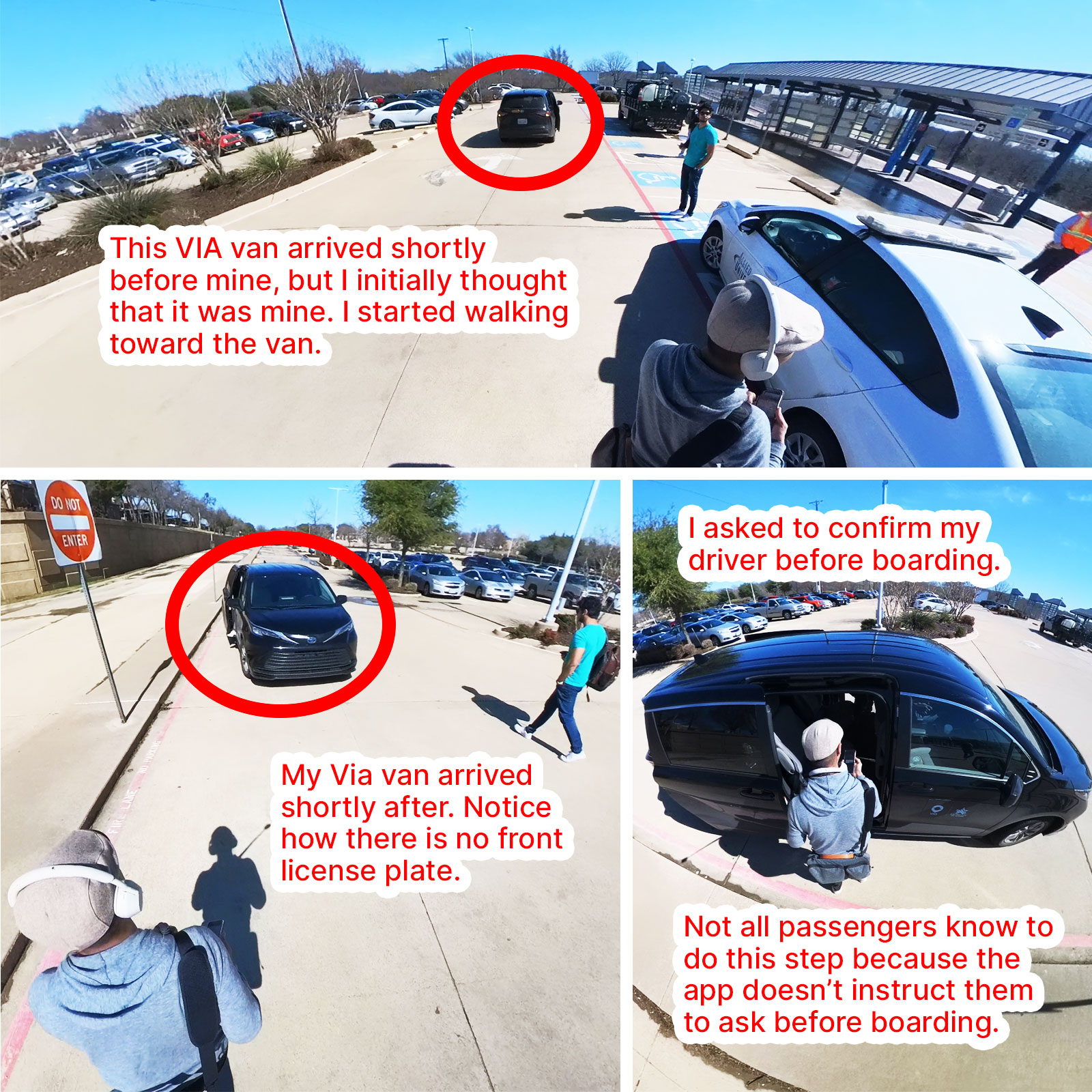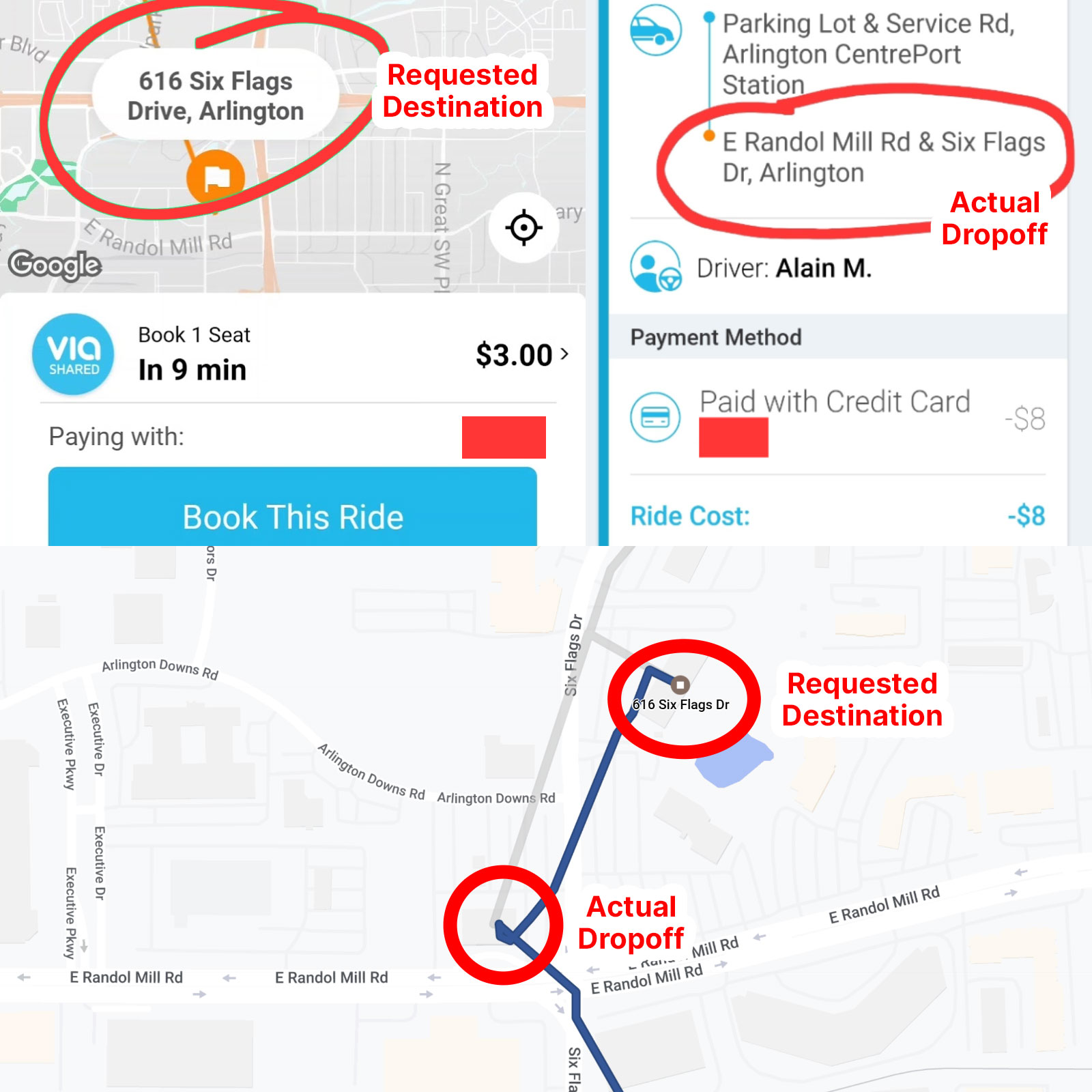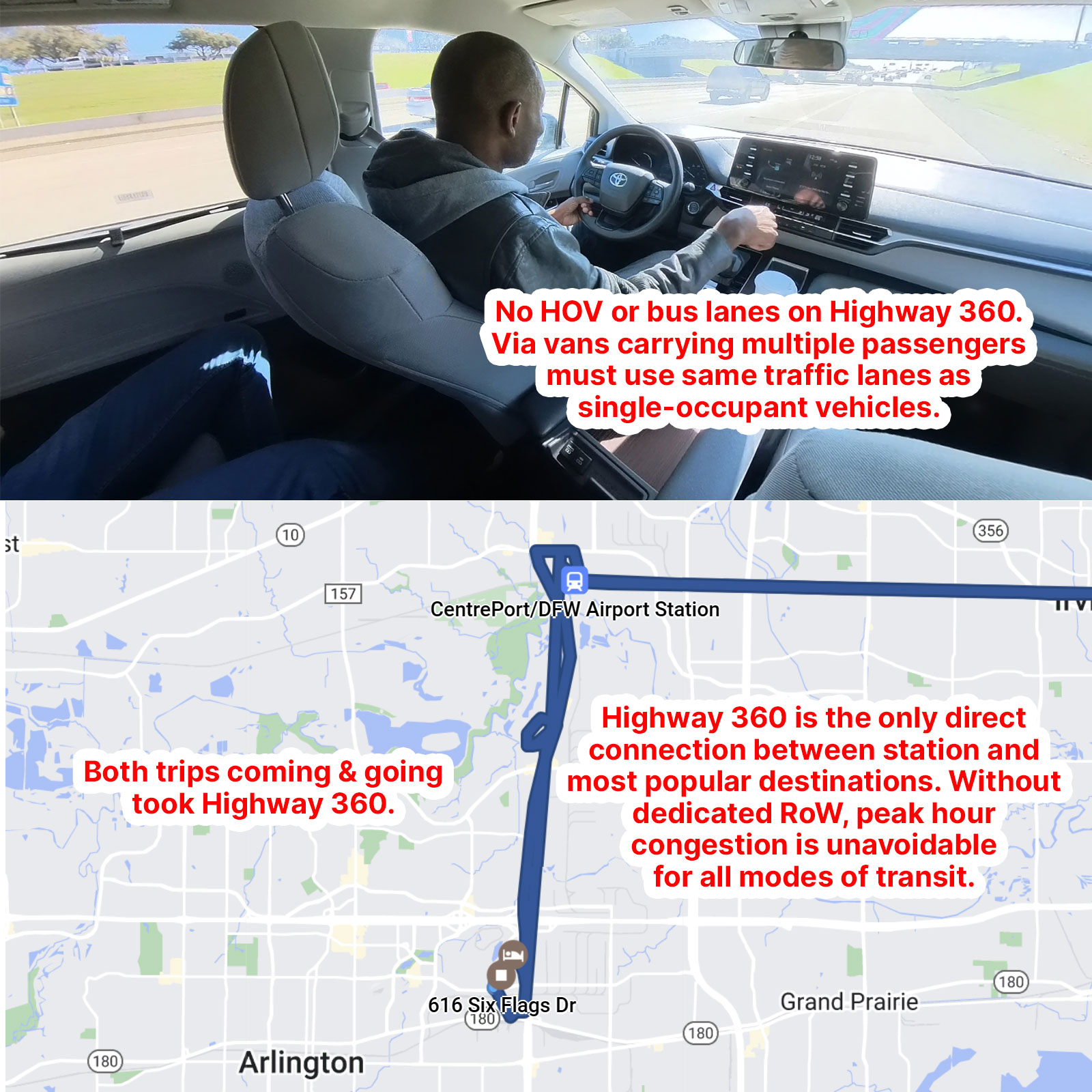Riding Via in Arlington, Texas: Observations and Recommendations
Observations and recommendations for addressing issues with Arlington's mobility on-demand service.
By Hexel Colorado on April 10, 2023
In February, I took a Via ride to the NCTCOG headquarters to observe the monthly meeting of the Regional Transportation Council but arrived late to the public comment portion due to Via delays. Here are my observations and recommendations for addressing the issues.
Difficulty Differentiating Between Vans

The first issue was the confusion caused by indistinguishable vans, which increases the risk of passengers mistakenly boarding the wrong vehicle. At the station, multiple Via vans arrive at the same time and passengers are supposed to board a specific van. I asked my driver about his experience, and he said he deals with passengers entering the wrong vehicle on a regular basis. I almost did two black Via vans arrived almost simultaneously. The chance of human error is high for several reasons:
- The vans are all identical in body type and color, making it difficult to distinguish them from a distance.
- Some vans do not have front license plates, making it inconvenient to verify them through the app.
- The app does not remind riders to double-check that they are boarding the correct vehicle.
To avoid this problem, small but noticeable changes could be made to each vehicle’s appearance, such as adding decals and lettering to make them more distinguishable from one another. Additionally, it would be helpful if the app displayed instructions immediately after booking a ride, reminding passengers to verify that they are entering the correct vehicle before doing so.
Silent and Unexpected Drop Off Location Changes

The second issue I observed while using Via was silent and unexpected drop-off location changes. I had inputted the correct address for my drop-off location, but at some point, during the ride, my drop-off location changed without my knowledge. This resulted in the driver bringing me to the wrong building and significantly delaying my arrival time.
Arlington Via needs to make it a high priority to do rigorous quality assurance testing of the booking system on their app. Without complete confidence in the stability of the booking system, there is no way to meaningful measure the performance of the service and the behavior patterns of riders.
No Instructions to Wait Outside Apartment Gates for Pickup

During my trip, the Via van added a pickup passenger mid-trip who had booked the ride from inside their apartment complex. However, the Via van could not enter the gates of the apartment complex, and for unclear reasons, the GPS navigation for the van driver instructed him to park on a side street, rather than in front of the apartment complex main office. Additionally, because the driver had no way to tell what the passenger looked like, we waited several minutes for someone walking toward us from across the street but who turned out to be a passerby.
To tackle these issues, Via could take the following steps:
- Add a note to the app advising passengers to wait outside the gates, which would help prevent delays and confusion.
- Allow passengers to upload a profile picture and brief description of their appearance, which would make it easier for drivers to identify them.
- Consider having fixed stop locations with visible signage, similar to GoLink, Via’s counterpart in Dallas.
Pitifully Small Recommended Tip Amounts

The recommended tip amounts for Via drivers are quite low, with the highest 25% tip being only 75 cents due to the fixed $3 rate. This can demotivate drivers from providing quality service. As a passenger, I felt obliged to tip more than the recommended amount, particularly since my driver was helpful and answered all my queries. To tackle this issue, Via could recommend flat dollar amounts – such as $1, $3, and $5 – instead of recommending tips based on percentage.
Susceptibility to Heavy Traffic

Highway 366 connects CentrePort Station directly to Downtown Arlington, UTA, and their entertainment district, making it the primary route for most trips on Via. However, this also means that these trips are highly prone to traffic congestion, particularly during rush hour. When I saw the traffic jam on the highway, I asked my driver how challenging it is to provide service during such periods, and he described it as a daily struggle.
I have three recommendations to address this issue.
First, create an HOV or bus lane by converting a general drive lane. This would allow Via vans and other multi-passenger vehicles to bypass traffic and improve service, particularly during rush hour when most vehicles have only one occupant. The cost of implementing this initiative would be justified by the reduction in single-occupancy vehicles.
Second, establish a short-run, high-frequency express bus route between CentrePort and the entertainment district with a single stop. This would provide a convenient transit option for the thousands of people who travel to Arlington’s top destination.
Third, program Via to incorporate the express bus as the first leg of all trips between CentrePort and south of I-30, similar to how DART’s route planner allows riders to connect with GoLink, traditional bus, and rail. This would streamline the transit experience for riders and improve the efficiency of the system.
Big Idea: Make Via Multi-Modal
Currently, if a rider at CentrePort books a ride to UTA through Via, a van is dispatched to pick up the rider and carry them for the entire trip, navigating through all the traffic along the way. This approach can be inefficient, especially if there are additional riders picked up mid-trip. It also makes it challenging to estimate a passenger’s drop-off time, causing anxiety for riders who need to arrive at their destination on time.
However, imagine if Via were to split the trip into two legs. The express bus could make only one other stop in front of Globe Life Field, resulting in 10- to 15-minute headways. This wait time is typical for pickups by Via, Uber, and Lyft at the station. The wait time could even be reduced by syncing the bus schedule with the arrival of TRE trains. Because the multi-modal trip is booked through the app, Via can dispatch the van to arrive at Globe Life Field just in time to receive the passenger for the 3-mile last leg to UTA. This approach would help reduce traffic congestion and make the trip more predictable for riders.
By combining the multi-modal approach with my previous two recommendations, several benefits can be achieved:
- Passengers traveling to destinations such as Globe Life Field or nearby venues can be served efficiently and quickly by the express bus.
- The express bus can easily maintain headways due to its short, fixed route with minimal stops.
- Via vans can provide faster service to customers due to shorter trip lengths.
- Riders can reach their final destination faster than before.